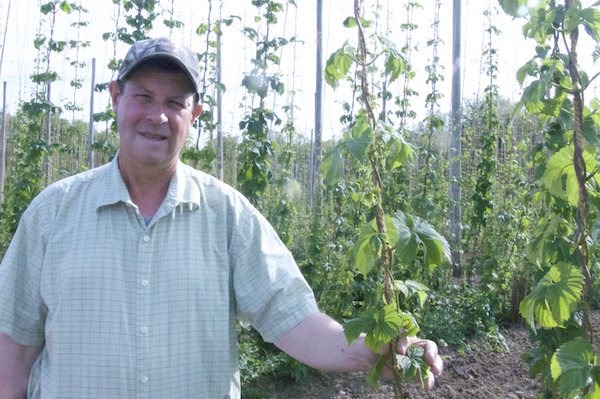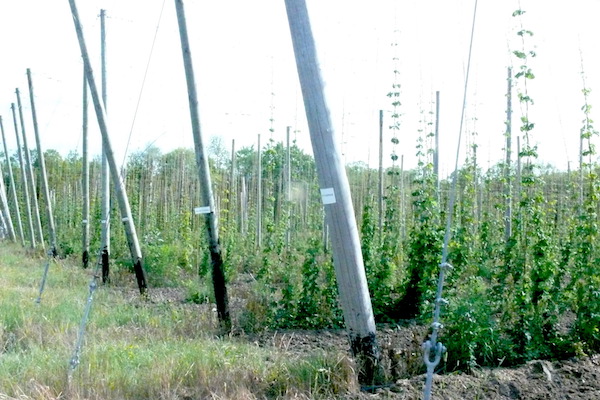Kendall family grows hops, an uncommon crop in Orleans County

Photos by Ginny Kropf: John Woodams stands among his rows of hops bines, which will be ready to harvest in September.
KENDALL – John and Kim Woodams are not only one of the most unusual business owners to graduate from the Microenterprise Assistance Program, but they are one of the few in the area to operate a hops farm.
John Woodams of Kendall, who works full time as a spindle grinder for Gleason Works in Rochester, started raising hops on the family farm five years ago. The farm was started by his grandfather, who bought it during the Depression for $100. The transaction was completed on the courthouse steps in Albion, John said.

Photo courtesy of the Woodams family: The Woodams family from Kendall is shown in their hops field. From left is Elizabeth, John, Eric, Kim and Ethan.
The farm was then handed down to his father, Richard, who started growing Christmas trees in 1987. John took it over and kept the Christmas tree business, but decided to add hops when he heard about them, quite by accident.
One year a customer who came to get a Christmas tree mentioned that his brother was a taster for Coors beer, and the conversation turned to raising hops. Hops used to be a big crop in the area during the 1800s and early 1900s, John said. But they got a disease, and there weren’t the chemicals then to treat them, so the hops all died out.
Woodams explained hops is the base for beer – a bittering agent which is added to malt to offset its sweetness.
There are different varieties and tastes of hops, Woodams said. He talked to a supplier in Michigan, who helped get him started raising hops. With help from his wife Kim, sons Ethan and Eric and daughter Elizabeth, the family planted 10 acres of hops, or 5,000 “bines” as they are called. Each one had to be tied on a 21-foot string. The strings are then tied onto a trellis which stretches across the entire 10 acres.
Raising hops is very labor intensive, John said. Besides planting each bine individually and then tying it to the string, they have to be sprayed and the ground treated to maintain its rich soil.
“There a lot of manual labor,” Kim said. “In the spring, we have to ‘train’ the bines to climb the string, or ‘coir’ as it is called.”
Besides helping in the field, driving tractor and twisting the vines, Kim is bookkeeper for their operation.
Hops produce a green pine cone, which is picked off the bines by a harvester, usually in September. Each bine is fed into the harvester, which strips off the cones. The cones go into apple crates and are put in a storage barn where dryers dry them down by 90 percent to 10 percent.
The bines produce a small harvest the first and second years, John said. It is generally not until the fourth year they produce a full harvest. He said each plant grows 20 pounds of hops.
John said he heard about the Microenterprise Assistance Program from Jim Whipple, who is now retired as chief executive officer of the Orleans Economic Development Agency.
“I was looking to put a business plan together and he suggested we talk to Diane Blanchard,” John said. “The class provided a lot of information on how to set up a business plan, project cash flow and determine profit and loss.”
He also praised Jon Costello, who is a mentor to the Microenterprise classes.
“He was a real asset to us,” John said.

Rows of hops are tied on string which is strung from 21-foot wires in their hops field.



































































